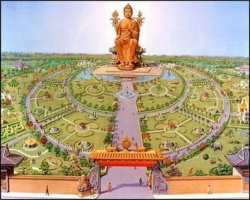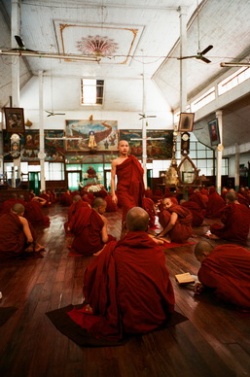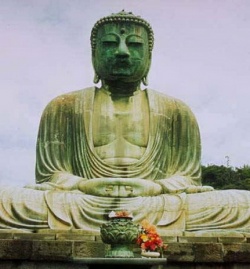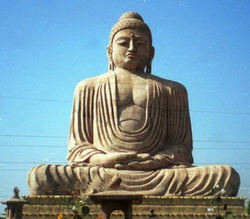Vacuum States of Consciousness: A Tibetan Buddhist View By Alan Wallace
- Abstract
In the early Theravada Buddhist view, the Bhavaṅga, literally, the “ground of becoming,” may be characterized as a relative vacuum state of Consciousness, voided of all manner of mental activity known as javana. This appears to be identical to the substrate Consciousness (ālayavijñāna) asserted in the later Great Perfection (Dzogchen) school of Tibetan Buddhism. This state of Consciousness is presented not simply as a philosophical speculation but as an experienced mental phenomenon that can be accessed through the achievement of meditative quiescence (śamatha). According to the Great Perfection school, primordial Consciousness (jñāna) may be regarded as an ultimate ground state of Consciousness, and it can allegedly be ascertained non-dually through the cultivation of contemplative insight (vipaśyanā). These relative and ultimate vacuum states of Consciousness bear remarkable similarities with the definitions of relative and absolute vacuum states of space presented in contemporary physics. The Buddhist and scientific views may be regarded as complementary, each having its own strengths and weaknesses.
Twenty-five hundred years ago, the Hebrew people were living in exile in Babylon, with their prophets crystallizing their religious faith and belief in the one true God. In doing so, they were creating the paradigm for what we in the West now call religion. During the same period, the first Greek pre-Socratic thinkers on the Ionian coast of Asia Minor were emphasizing the use of speculative reason in the quest for the one fundamental stuff underlying the physical world. In doing so, they were laying the foundations for what we now call philosophy and science. In the meantime, another way of exploring reality was emerging in India that has played at most a peripheral role in the West, but which has the potential to provide an important bridge between religion, on the one hand, and science and philosophy on the other.
In the midst of this diverse social milieu, a loose-knit movement of counter-cultural contemplatives (śrāmaṇas) emerged, consisting of individuals who were primarily interested in fathoming by means of direct experience the nature and potentials of Consciousness and its relation to the lived world of experience (loka). Their primary means for exploring the mind was first subjugating the passions, then developing advanced degrees of meditative concentration (samādhi). Considering their focus on spiritual liberation (mokṣa), we might regard this movement as a religious reformation; or, given their emphasis on observation, experimentation, and reason, it could be deemed a scientific revolution. But I find it more fitting to call it a Noetic Revolution, drawing from the Greek term noetos, referring to the cognitive faculty that apprehends non-sensuous phenomena.
The Buddhist exploration of the mind and the rest of the natural world, which grew out of this Noetic Revolution, began with Siddhartha Gautama, but it did not end with him. Since his time, one hundred generations of Buddhist contemplatives have engaged in their own investigations, following his themes of pragmatism, skepticism, empiricism, and rationalism. Out of these centuries of inquiry has emerged a theory of Consciousness that first of all distinguishes between mental activity, called javana, and the mental ground out of which such activity emerges, known as the Bhavaṅga.[1] The early Buddhist term javana refers to all types of active mental processes, including sensory perceptions, discursive thoughts, memories, intentions, desires, and imagination. These are the dynamic processes of the space of the mind, many of which can be observed by means of mental perception.
The cognitive basis of all mental activities and sensory perceptions is the Bhavaṅga, literally, the ground of becoming, which supports all kinds of javana, as the root of a tree sustains the trunk, branches, and leaves.[2] This is the resting, ground state of Consciousness, withdrawn from the physical senses. While all mental and sensory processes are conditioned by the body and the environment, in the Buddhist view they actually emerge from the Bhavaṅga, not the brain. Described as the natural, unencumbered state of the mind, its innate radiance and purity are present even when the mind is obscured by afflictive thoughts and emotions.[3] The Bhavaṅga may be characterized as a “vacuum” state of Consciousness, voided of all manner of javana. Generally speaking, it is indiscernible while the mind is active, for it normally manifests only in dreamless sleep and during the very last moment of a person’s life. Indeed, Buddha declared that there are multiple similarities in the cognitive processes while falling asleep and dying.[4]
To unlock this natural purity and luminosity of Consciousness so that its radiant potential is revealed, one must calm the involuntary activity of the mind through the practice of meditative quiescence.[5] In this way, one can see through the superficial turbulence of the mind into its limpid depths. In the Buddhist view, the Bhavaṅga acts as the basis for all volitional states of Consciousness, and thus for Karma; and it is therefore the basis for the emergence of the world experienced by each individual.
The world each of us experiences does not consist of an independent subject observing independent objective phenomena. Rather, the various modes of sensory and mental Consciousness arise from moment to moment in relation to the phenomena that appear to them and in dependence upon those cognitive faculties. The duality of subject and object is something conceptually superimposed on experience, not something that is discovered through empirical observation. So without resorting to the stance of philosophical idealism, it may be said that the Bhavaṅga serves as the nondual source of creation of each person’s experienced-world-and-its-experiencer.
The above account of javana and the Bhavaṅga is based on the Buddha’s discourses recorded in the Pāli language and their earliest commentaries. A remarkably similar description of the ground state of Consciousness appears in the later Great Perfection (Dzogchen) school of Tibetan Buddhism. Here a distinction is made between the substrate (ālaya) and the substrate Consciousness (ālayavijñāna). Tibetan contemplatives describe the substrate as the objective, empty space of the mind. This vacuum state is immaterial like space, a blank, unthinking void into which all objective appearances of the physical senses and mental perception dissolve when one falls asleep; and it is out of this vacuum that appearances re-emerge upon waking.[6]
The subjective Consciousness of this mental vacuum is called the substrate Consciousness. In the natural course of a life, this is repeatedly experienced in dreamless sleep and finally experienced in the moment before death. A contemplative may consciously probe this dimension of Consciousness through the practice of meditative quiescence, in which discursive thoughts become dormant and all appearances of oneself, others, one’s body and one’s environment vanish. At this point, as in the cases of sleeping and dying, the mind is drawn inwards and the physical senses become dormant. What remains is a state of radiant, clear Consciousness that is the basis for the emergence of all appearances to an individual’s Mind-stream. All phenomena appearing to sensory and mental perception are imbued with the clarity of this substrate Consciousness. Like the reflections of the planets and stars in a pool of limpid, clear water, so do the appearances of the entire phenomenal world appear within this empty, clear substrate Consciousness. Contemplatives who have penetrated to this state of Consciousness describe it as “an unfluctuating state, in which one experiences bliss like the warmth of a fire, luminosity like the dawn, and nonconceptuality like an ocean unmoved by waves.”[7]
The above description can easily be misinterpreted as an expression of philosophical idealism. However, these contemplatives are not claiming that the entire universe is of the nature of the mind, only that one’s individual world of appearances arises from this substrate Consciousness. Moreover, the qualities of bliss, luminosity, and non-conceptuality associated with the realization of the substrate Consciousness have led many contemplatives to mistake this for the ultimate nature of reality, or nirvāṇa. But simply dwelling in this relative vacuum state of Consciousness does not liberate the mind of its afflictive tendencies or their resultant Suffering. By fathoming the nature of the substrate Consciousness, one comes to know the nature of Consciousness in its relative ground state. This realization, however, does not illuminate the nature of reality as a whole. It is also important not to confuse this substrate Consciousness with a collective unconscious, as conceived by Carl Jung. Buddhist accounts of the substrate Consciousness all refer to it as an individual stream of Consciousness that carries on from one lifetime to the next.
The Buddhist tradition claims that the appearances to our senses do not exist in external, physical space, independent of perception. Likewise, the objects that make up our experienced world, each of them imbued with sensory attributes, such as color, taste, smell, and texture, are not to be found in the objective space described by modern physics. But within the context of our experienced world, it is conventionally valid to say that the physical objects we perceive in the world around us, such as planets and stars, exist within the external, intersubjective space of Consciousness; and the mental objects we perceive, such as thoughts and mental images, exist in the internal, subjective space of the Consciousness of each individual.
Neuroscientists commonly assume the human brain exists in the real, objective space of physics, but all their sensory images and concepts of the brain appear in the space of Consciousness. Moreover, all the sensory images of space experienced by physicists arise within the external space of their Consciousness, and all their concepts of space emerge within the internal space of Consciousness. Although we may believe in the existence of space independent of Consciousness, all our concepts of such real, objective space arise within the space of Consciousness. As for the relation between sensory images and their related objects believed to exist in the objective world independent of Consciousness, neurologist Antonio Damasio acknowledges, “There is no picture of the object being transferred from the object to the retina and from the retina to the brain.”[8] To generalize, the appearances to our senses are not replicas, or re-presentations, of phenomena in objective, physical space. They are fresh creations arising in the space of Consciousness. Likewise, our concepts of space and the objects within it are not replicas of anything existing independently of the mind. In short, the brain believed by neuroscientists to exist in real, objective space is as devoid of Consciousness as is the physical space conceived of by physicists.
Neither the external space of the physical senses nor the internal space of the mind exists in the brain, nor are any of the contents of such external or internal space located inside the head. Within the context of the experienced world, the demarcation between external and internal space is one of convention, not absolute reality. We may experience mental images, for example, not only in our “mind’s eye,” with our eyes closed and our attention withdrawn from the physical world. We may also superimpose mental images on our sensory fields of experience. For example, we may imagine the face of a man on the moon or an archer outlined in a configuration of stars.
Does the face or the archer we imagine exist in internal space or external space? They are free creations of the mind, yet they appear to be in external space; but that external space may be singularly subjective, not intersubjectively experienced by all competent observers. On the other hand, when we turn our attention inwards and focus on a mental image of the moon, the image we perceive mentally may be virtually identical to other people’s mental images of the moon. While occurring in the internal space of our minds, it is more intersubjective than the images we externally superimpose on the constellations. In short, there is nothing inherently external or intersubjective about external space, nor is there anything inherently internal or private about internal space. While we commonly speak of directing the attention outward to the physical world or inward to the mind, this distinction is only conventional. Our experience presents us only with the nondual space of Consciousness, in which the distinctions between outer and inner are artificially superimposed by concepts and language.[9]
In the Great Perfection tradition of Tibetan Buddhism, the nonduality of external and internal space is called the dharmadhātu, or absolute space of phenomena. Out of this space emerge all the phenomena that make up our intersubjective experienced world. All appearances of external and internal space, time, matter, and Consciousness emerge from the dharmadhātu and consist of nothing other than configurations of this absolute space. While the relative vacuum of the substrate can be ascertained by means of the cultivation of meditative quiescence, the absolute vacuum of the dharmadhātu can be realized only through the cultivation of contemplative insight.[10] The mode of awareness with which one ascertains this absolute space is called primordial Consciousness (jñāna), which is the ultimate nature of all individual continua of Consciousness.
The experiential realization of absolute space by primordial Consciousness transcends all distinctions of subject and object, mind and matter, indeed, all words and concepts. Such insight does not entail the meeting of a subjective mode of Consciousness with an objective space, but rather the nondual realization of the intrinsic unity of absolute space and primordial Consciousness. The dharmadhātu and primordial Consciousness are coterminous, nonlocal, and temporal. While the dharmadhātu is the fundamental nature of the experienced world, primordial Consciousness is the fundamental nature of the mind. But since the two have always been of the same nature, the view of the Great Perfection is not one of philosophical idealism, dualism, or materialism. All such distinctions between subject and object, mind and matter are regarded as mere conceptual fabrications.
The unity of absolute space and primordial Consciousness is the Great Perfection, often referred to as the “one taste” of all phenomena and the “purity and equality of the whole of samsāra and nirvāṇa.” The previously discussed substrate Consciousness may be called a relative, or false, vacuum state of Consciousness, for it is different from the substrate which it ascertains; it is qualified by distinct experiences of bliss, luminosity, and nonconceptuality; it is ascertained when the mind is withdrawn from the external world; and it is bound by time and causality. Therefore, despite its vacuity, it has an asymmetrical, internal structure. The unity of absolute space and primordial Consciousness, on the other hand, is the absolute, or true, vacuum. Although it, too, is imbued with the qualities of bliss, luminosity, and nonconceptuality, these are not present as distinct attributes but as an ineffable unity. This absolute vacuum is fathomed while letting Consciousness come to rest in a state of nonduality, open to the entire universe. Devoid of all internal structure, it embodies a unique, absolute symmetry that transcends relative space, time, mind, and matter.
The substrate Consciousness may be characterized as the relative ground state of the individual mind, in the sense that, within the context of an individual Mind-stream, it entails the lowest possible state of activity, with the highest possible potential and degree of freedom or possibility. For example, once an individual stream of Consciousness has been catalyzed from its own substrate in dreamless sleep, it can freely manifest in a vast diversity of dreamscapes and experiences. Such exceptional creativity is also displayed while under deep hypnosis, which also taps into the substrate Consciousness. But this potential is most effectively accessed when one lucidly penetrates to the substrate Consciousness by means of meditative quiescence. In this case, one is vividly aware of the substrate, in contrast to the dullness that normally characterizes dreamless sleep. Buddhist contemplatives report that such fully conscious realization of the relative ground state of Consciousness opens up a tremendous wellspring of creativity, which is largely obscured in the normal experiences of the substrate while sleeping or dying.
Primordial Consciousness, on the other hand, may be characterized as the absolute ground state of Consciousness. This state of perfect symmetry entails the lowest possible state of mental activity, with the highest possible potential and degree of freedom in the universe. In the limited, relative vacuum of the substrate—as in the case of deep sleep—mental events specific to one individual emerge and dissolve back into that subjective space of Consciousness. But all phenomena throughout time and space emerge from and dissolve back into the timeless, infinite vacuum of absolute space.
When one realizes the substrate Consciousness by achieving meditative quiescence, mental afflictions are only temporarily suppressed, but as a result of realizing primordial Consciousness, it is said that all mental afflictions and obscurations are eliminated forever. Likewise, the bliss that is experienced when resting in the relative ground state of Consciousness is limited and transient, whereas the inconceivable bliss that is innate to the absolute ground state of primordial Consciousness is limitless and eternal. By ascertaining the substrate Consciousness, one realizes the relative nature of individual Consciousness, but in the realization of primordial Consciousness, the scope of one’s awareness is said to become limitless. Likewise, the creative potential of Consciousness that is accessed through meditative quiescence is limited, whereas that which is unveiled through such ultimate contemplative insight allegedly knows no bounds. Thus, in reference to this absolute ground state of Consciousness the Buddha declared, “All phenomena are preceded by the mind. When the mind is comprehended, all phenomena are comprehended. By bringing the mind under control, all things are brought under control.”[11]
The above uses of the terms relative and absolute vacuum are not found in Buddhist literature, though I am confident that this presentation does not distort traditional Buddhist accounts of the substrate, substrate Consciousness, the absolute space of phenomena, or primordial Consciousness. I have borrowed these terms from modern physics, and in so doing I invite a comparison between scientific and Buddhist concepts of vacuum states of space and of Consciousness. In physics, a vacuum is commonly defined as the lowest possible energy state of a volume of space, and this definition can be applied to numerous other systems, such as an electric charge embedded in space. I have taken this definition and applied it to Consciousness.
A false vacuum is one that is not utterly devoid of energy, but it is the lowest possible energy-state under present circumstances. Such a vacuum has energy and structure and is therefore not perfectly symmetrical. Any configuration of mass-energy, including light itself, is viewed by physicists as an excitation of empty space, or more accurately, as an oscillation of abstract field quantities in space, not an oscillation of space itself. The fluctuating masses in a vacuum are regarded metaphorically as “frozen energy,” and they cause a curvature of space, such that the distances between two points in space also fluctuate. Physicist Henning Genz writes in this regard, “Real systems are, in this sense, ‘excitations of the vacuum’—much as surface waves in a pond are excitations of the pond’s water…the properties of the physical vacuum define the possible excitations—the possible systems that can emerge from the physical vacuum…The vacuum in itself is shapeless, but it may assume specific shapes. In doing so, it becomes a physical reality, a ‘real world.’”[12]
Scientists do not have a clear idea of the true vacuum—of whatever remains once they have removed from some well-defined space everything that the laws of nature permit them to take away. The reason is that this depends on the laws of nature—all of them, including those that scientists have not yet discovered. In the frozen, or false, vacuum, quarks, electrons, gravity, and electricity are different, whereas in the perfect symmetry of the true, or melted, vacuum, which is devoid of any internal structure, they are undifferentiated. According to science writer K. C. Cole, “The closest we can probably come to imagining perfect symmetry is a smooth, timeless, featureless empty space—the proverbial blank slate, the utter silence. It can’t be perceived because nothing can change. Everything would be one and the same; everything would be the same, as far as we could tell, as nothing.”[13]
The evolution of the universe, according to some cosmologists, started with the perfect symmetry of the true vacuum, which cooled into our current frozen vacuum state, which may one day melt down again. This release of energy may explain the origination of the Big Bang. Cole writes in this regard, “Like water freezing into ice and releasing its energy into its surroundings, the ‘freezing’ of the vacuum liberates enormous amounts of energy…As simply as water freezing into ice, the inflated vacuum froze into the structure that gave rise to quarks, electrons, and eventually us.”[14] And Genz suggests, “Maybe quantum mechanical fluctuations initiated not only the stuff our world was made of prior to inflation but also space-time itself. Maybe the true vacuum, the true nothing, of philosophy and religion should be seen as a state wholly innocent of laws, space, and time. This state can be thought of as nothing but a collection of possibilities of what might be.”[15]
The above views concerning the role of the true vacuum of physical space in the formation of the universe bear a remarkable similarity with Buddhist views concerning the relation between the absolute space of phenomena and the relative world of space and time, mind and matter. In his recent book on the Great Perfection, the Dalai Lama writes, “Any given state of Consciousness is permeated by the clear light of primordial awareness. However solid ice may be, it never loses its true nature, which is water. In the same way, even very obvious concepts are such that their ‘place’, as it were, their final resting place, does not fall outside the expanse of primordial awareness. They arise within the expanse of primordial awareness and that is where they dissolve.”[16]
While physicists have devised their theories of the true and false vacuums on the basis of physical experiments and mathematical analysis, Buddhists have formulated their theories of true and false vacuum states of Consciousness on the basis of contemplative experience and philosophical analysis. Both traditions place a high priority on empirical investigation and rational analysis, but their starting assumptions and modes of observation are profoundly different. The Scientific Revolution began with the assumption that an external God created the world prior to and independently of human Consciousness. Physicists then set themselves the goal of perceiving that objective universe from a “God’s-eye” perspective and formulating its laws in terms of God’s own language, which they thought to be mathematics. Since they were focused on the realm of objective space and its contents that exist independently of Consciousness, it was quite natural for them to marginalize the role of mind in nature; and their theories of the true and false vacuums naturally make no reference to Consciousness.
Indeed, advocates of this mechanistic view have assumed from the outset that Consciousness plays no significant role in the universe. As Antonio Damasio proclaims, “Understanding Consciousness says little or nothing about the origins of the universe, the meaning of life, or the likely destiny of both.”[17] Such confidence is remarkable in light of the fact that neuroscientists have not yet discovered the nature or origins of Consciousness. In the meantime, many neuroscientists share what Damasio calls his “one goal and one hope,” namely to formulate a comprehensive explanation for how the sort of neural patterns that can be currently described with the tools of neurobiology, from molecules to systems, give rise to states of Consciousness.[18] Such researchers commonly assume that they already know that Consciousness has no existence apart from the brain, so the only question to be solved is how the brain produces conscious states. This assumption is an instance of what historian Daniel Boorstin calls an “illusion of knowledge.” It is these, he proposes, and not mere ignorance, that have historically acted as the greatest impediments to scientific discovery.[19]
The significance of the vacuum states of physical space and of Consciousness can hardly be overestimated. Physicist John March-Russell declares, “The current belief is that you have to understand all the properties of the vacuum before you can understand anything else.”[20] Physicists have not yet fathomed all the properties of the vacuum or all the laws of nature, but they have widely assumed that Consciousness is irrelevant to the universe they are trying to understand. Insofar as the universe conceived by physicists exists independently of Consciousness, Buddhists may counter that such a universe is irrelevant to the world of human experience, in which Consciousness plays a crucial role.
Neither the scientific nor the Buddhist view of the vacuum is complete. The scientific view of the universe has little to say about the origins, nature, or role of Consciousness in nature. And the Buddhist view has no objective, quantitative means of examining vacuum states of space. Rather than viewing the modes of inquiry of these two great traditions as incompatible, it may be more fruitful to regard them as complementary. Like focusing two eyes on the same reality, with the integration of these two perspectives, we may discover a deeper and more encompassing vision than either tradition has achieved on its own.
Footnotes
- ↑ Peter Harvey, The Selfless Mind: Personality, Consciousness and Nirvana in Early Buddhism (Surrey: Curzon Press, 1995).
- ↑ Bareau, A. (1955) Les Sectes Bouddhiques du Petit Véhicule (Paris: EFEO, 1955), 72.
- ↑ Aṅguttara Nikāya A.I.8-10.
- ↑ Peter Harvey, The Selfless Mind, 159.
- ↑ B. Alan Wallace, “The Buddhist Tradition of Śamatha: Methods for Refining and Examining Consciousness.” Journal of Consciousness Studies, 6, no. 2-3, 1999, 175- 187; B. Alan Wallace, The Bridge of Quiescence: Experiencing Tibetan Buddhist Meditation (Chicago: Open Court, 1998).
- ↑ Dudjom Lingpa, Dag snang ye shes drva pa las gnas lugs rang byung gi rgyud rdo rje’i snying po. Sanskrit title: Vajrah¸dayaśuddhadhutijñānahāreśrıla˙jātiyātisma. Collected Works of H.H. Dudjom Rinpoche, 68.
- ↑ Ibid., 31.
- ↑ Antonio Damasio, The Feeling of What Happens: Body and Emotion in the Making of Consciousness (New York: Harcourt, 1999), 321.
- ↑ For more elaborate discussions of this theme, see B. Alan Wallace, The Taboo of Subjectivity: Toward a New Science of Consciousness (New York: Oxford University Press, 2000), 62-67, 110-117; William James, Essays in Radical Empiricism.
(Cambridge, MA: Harvard University Press, 1912/1976). - ↑ H. H. the Dalai Lama, Dzogchen: The Heart Essence of the Great Perfection, trans. by Geshe Thupten Jinpa & Richard Barron (Ithaca, NY: Snow Lion Publications,2000).
- ↑ Ratnameghasūtra, cited in Śāntideva’s Śikṣāsamuccaya. ed. P. D. Vaidya (Darbhanga: Mithila Institute, 1961), 68.
- ↑ Henning Genz, Nothingness: The Science of Empty Space, trans. Karin Heusch (Cambridge, MA: Perseus Books, 1999), 26.
- ↑ K. C. Cole, The Hole in the Universe: How Scientists Peered over the Edge of Emptiness and Found Everything (New York: Harcourt, 2001), 244.
- ↑ Ibid., 177-8.
- ↑ Henning Genz, Nothingness, 312.
- ↑ H. H. the Dalai Lama, Dzogchen, 48-9.
- ↑ Antonio Damasio, The Feeling of What Happens, 28.
- ↑ Ibid., 322.
- ↑ Daniel J. Boorstin, The Discoverers: A History of Man’s Search to Know His World and Himself (New York: Vintage Books, 1985), xv.
- ↑ Cited in K. C. Cole, The Hole in the Universe, 235.
Bibliography
- Aṅguttara Nikāya
- Bareau, A. Les Sectes Bouddhiques du Petit Véhicule. Paris: EFEO, 1955.
- Boorstin, Daniel J. The Discoverers: A History of Man’s Search to Know His World and Himself. New York: Vintage Books, 1985.
- Cole, K. C. The Hole in the Universe: How Scientists Peered over the Edge of Emptiness and Found Everything. New York: Harcourt, 2001.
- H. H. the Dalai Lama, Dzogchen: The Heart Essence of the Great Perfection, trans. Geshe Thupten Jinpa & Richard Barron. Ithaca, NY: Snow Lion Publications, 2000.
- Damasio, Antonio. The Feeling of What Happens: Body and Emotion in the Making of Consciousness. New York: Harcourt, 1999.
- Dıgha Nikāya
- Dudjom Lingpa. Dag snang ye shes drva pa las gnas lugs rang byung gi rgyud rdo rje’i snying po. Sanskrit title: Vajrah¸dayaśuddhadhutijñānahāreśrıla˙jātiyātisma. Collected Works of H.H. Dudjom Rinpoche (no publication date).
- Genz, Henning. Nothingness: The Science of Empty Space, trans. Karin Heusch. Cambridge, MA: Perseus Books, 1999.
- Harvey, Peter. The Selfless Mind: Personality, Consciousness and Nirvana in Early Buddhism. Surrey: Curzon Press, 1995.
- James, William. Essays in Radical Empiricism. Cambridge, MA: Harvard University Press, 1912/1976.
- Śāntideva. Śikṣāsamuccaya, ed. P. D. Vaidya. Darbhanga: Mithila Institute, 1961.
- Wallace, B. Alan. “The Buddhist Tradition of Śamatha: Methods for Refining and Examining Consciousness.” Journal of Consciousness Studies, 6, no. 2-3, (1999): 175-187.
- --- The Bridge of Quiescence: Experiencing Tibetan Buddhist Meditation. Chicago: Open Court, 1998.
- --- The Taboo of Subjectivity: Toward a New Science of Consciousness. New York: Oxford University Press, 2000.






